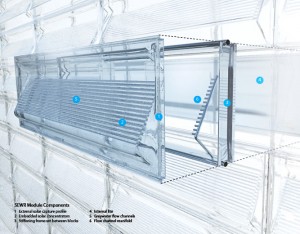
The Center for Architecture, Science and Ecology (CASE), have just picked up another award for their Solar Enclosure for Water Reuse (SEWR) system, and this time they have won the SPARK awards. CASE conducts interdisciplinary research focused on the next generation of building technologies for a sustainable built environment.
Solar Enclosure for Water Reuse or SEWR consists of a series of modular glass blocks, configured to capture, refocus and intensify sunlight and form the sheathing of the exterior surface for a building. The cast-glass blocks have carefully calculated profiles and each block features a standard flat lite on the interior surface, followed by a stiffening frame. The external lite has solar concentrators and graywater flow channels embedded in a surface that is tilted to capture the maximum amount of solar energy.
Inside the building, the blocks create a diffused daylight which eliminates solar heat gain, keeping rooms cooler and reducing the need for high-energy heating and cooling mechanisms. It’s also easier on the eyes. The graywater is directed from indoor plumbing such as faucets, baths, washing machines, and even toilets. It then runs through an initial screening and sedimentation process to remove contaminants.
The treated water flows through the channels in the SEWR facade system and is heated by the sun. The water is then directed back into the building for another round of treatment before being directed back into household systems. By keeping water treatment on site and limiting the amount of freshwater drawn from centralized grids, the system saves a lot of energy, and also drinking water from the nearby community. As a side effect the water also creates a barrier against heat as it runs though the glass facade. This reduced heat makes it possible to save additional energy, reducing the need for a central cooling system in the building.
CASE has previously won several awards for their innovative designs.
